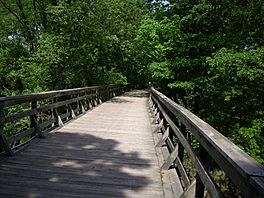MKT Trail facts for kids
Quick facts for kids MKT Trail |
|
|---|---|
 |
|
| Length | 8.9 mi (14.3 km) |
| Location | Boone County, Missouri, USA |
| Trailheads | Flat Branch Park 38°57′03″N 92°19′59″W / 38.95073°N 92.33312°W Hindman Junction (Katy Trail) 38°53′27″N 92°27′01″W / 38.89085°N 92.45035°W |
| Use | Hiking, Cycling, |
| Elevation change | negligible |
| Highest point | Downtown Columbia |
| Lowest point | McBaine Bottoms |
| Difficulty | Easy |
| Season | All |
| Hazards | Severe weather Poison ivy |
The MKT Nature and Fitness Trail is a fun path in Columbia, Missouri. It's about nine miles (14 km) long. This trail was once a railroad track for the Missouri–Kansas–Texas Railroad. That's why it's called MKT! It's a special kind of path called a "rail trail." You can walk, jog, or ride your bike on it all year round. In winter, if there's snow, you can even go cross-country skiing! The trail is made of crushed limestone, which makes a smooth, flat surface. It follows two creeks, Flat Branch Creek and Hinkson Creek, for a long way. The MKT Trail is also connected to the much longer Katy Trail, which is the longest rail trail in the United States.
Trail History
Building the MKT Trail
The MKT Trail started being built in 1982. It was created from an old railroad line. This line was no longer used by trains. The idea was to turn the old tracks into a place for people to enjoy nature and exercise. It quickly became a popular spot for everyone in Columbia.
Paving the MKT Trail
In 2006, a planner named Ted Curtis suggested paving the trail. Paving would make the trail stronger. It would also help it handle bad weather better. This plan was part of making more fun places for people to use.
However, many people did not like the idea of paving. They felt it would change the natural feel of the trail. Runners especially liked the soft surface. They worried paving would make it harder on their bodies.
Because of these concerns, the plan was changed. The new plan included a special soft shoulder for runners. It also added small paths leading to creeks. This way, people could still enjoy nature up close.

